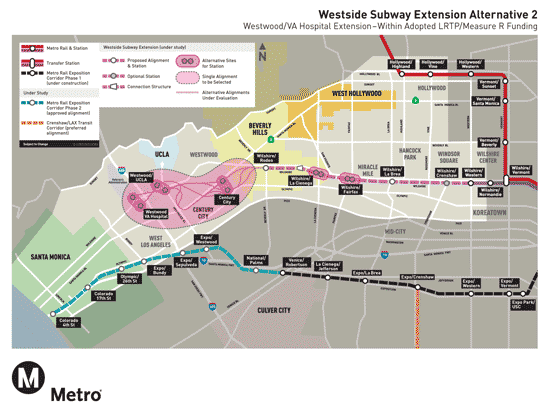Metro’s favored Westside Subway route [updated]
October 14, 2010
Racing the clock to obtain federal funding commitments for the Westside Subway in the next fiscal year, Metropolitan Transportation Authority staff this week recommended what it considers to be the best, most cost-effective route for the project.
Under the “locally preferred alternative” favored by Metro, the Purple Line subway would be extended nine miles from the current station at Wilshire and Western to the VA Hospital in Westwood, at a cost of about $4.2 billion. Building the VA Hospital station, in addition to one at UCLA, would provide an important access point for the subway west of the 405 Freeway, the staff report said.
Metro’s Board of Directors will consider the recommendation at its meeting on October 28. Whichever route the board adopts will then undergo intensive study during the project’s final environmental review process. The board’s adoption of a preferred route also will move the project into competitive consideration for federal dollars in fiscal 2012. Those funds, along with revenues from Measure R, the half-cent sales tax approved by voters in 2008, will be needed to build the subway.
“We’re looking for federal dollars and the subway project is a really good candidate,” said Martha Welborne, Metro’s executive director of countywide planning. “We want to make sure we’re in the next cycle, or we’ll miss a whole funding year.”
In addition to the hoped-for “New Starts” funding, the federal government also is being asked to help accelerate the pace of building the subway under the 30/10 Initiative. Under that plan, local leaders are seeking to borrow against future Measure R revenues in order to fast-track an array of regional transportation projects. The aim is to complete the projects in 10 years, instead of 30.
The staff’s recommendation on the subway route came during the final stretch of a 45-day public comment period. But there’s still time to weigh in before the October 18 deadline. The electronic comment form is here.
The staff recommendation is one of five route alternatives—ranging in cost from about $4 billion to $8.7 billion—that were considered in the project’s Draft Environmental Impact Statement/Environmental Impact Report, issued in September. One of those would have added a series of subway stations in West Hollywood but Metro staff rejected that option, saying there is not enough funding to build the West Hollywood stops in addition to the Purple Line extension to the VA. That recommendation came as a disappointment to those in the community who had advocated strongly for the West Hollywood stations.
“There are a lot of disappointed people,” said Dan Wentzel, an actor/writer and transit advocate who writes a blog called The Pink Line. He said voters in West Hollywood had supported Measure R more than those in other cities, and have collectively responded to the subway plan by saying, “Build here! Build here!”
In Beverly Hills, however, many residents have expressed serious concerns about tunneling under homes and schools, particularly under Beverly Hills High School.
A full page ad in this week’s Beverly Hills Weekly, signed by more than 350 people and endorsed by numerous organizations, voiced support for a subway route under Santa Monica Boulevard and strongly opposed alternatives that would go under the high school.
A column in the newspaper quoted a Beverly Hills City Councilman, Barry Brucker, as calling Metro’s staff recommendation on the subway route a “slap in the face.”
In an interview, Brucker faulted the Metro report’s “glaring omission” of community concerns about tunneling under the high school–which he said is the primary issue about the subway in town.
“Not one word about the high school,” he said. “That led the whole community to believe this is all a whitewash and a fait accompli.”
The staff-recommended route would have seven stations, six of them along Wilshire Boulevard: La Brea, Fairfax (next to the Los Angeles County Museum of Art,) La Cienega, Rodeo Drive, Westwood/UCLA and the VA Hospital. The line also would extend into Century City for one station before rejoining Wilshire. The staff recommended leaving the exact placement of the Century City and Westwood stations open for further analysis during the final environmental review process.
The staff recommendations, contained in a report to Metro committees scheduled to meet next week, propose dropping a possible station at Crenshaw and Wilshire. Doing so would save $153 million and improve the project’s “cost-effectiveness index” (a measurement of cost per hour of “user benefit”) to $31.96, the staff report said. That would make the subway a better candidate for inclusion in the next phase of the Federal Transit Administration’s “New Starts” program, which favors projects with a cost-effectiveness index of $31 or less.
The staff also recommended against building a “connection structure” that would have served as a gateway for future heavy rail stations in West Hollywood. It suggested that other transit alternatives—such as a light rail subway—might end up being a more cost-effective option for West Hollywood, which would make the structure unnecessary.
Transit blogger Wentzel said he was encouraged by the report’s acknowledgment that a West Hollywood line “has very high potential as a transit corridor.”
“That’s the one silver lining,” Wentzel said, describing himself as a continuing subway backer and an optimist about bringing transit alternatives to West Hollywood. “It’s a miracle how far the Santa Monica Boulevard corridor has come.”
Posted 10/14/10
Updated 10/21/10: Metro’s Board of Directors will consider the Westside Subway project at their meeting at on Thursday, Oct. 28. For more information, including how to get there via public transportation, click here.













 405 bridge work causes a stink
405 bridge work causes a stink

